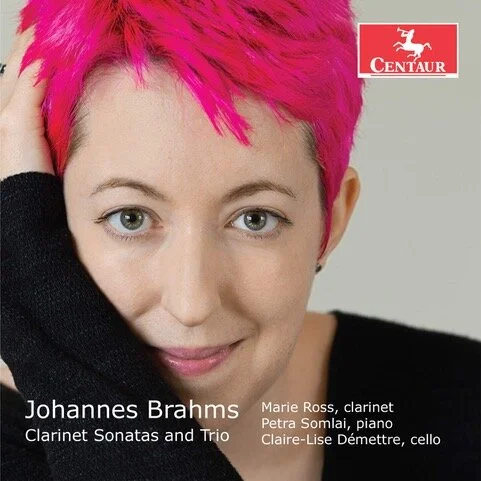Johannes Brahms: Clarinet Sonatas and Trio
Johannes Brahms planned to retire from composing in 1890 after the premiere of his second String Quintet. He was lured back on hearing clarinettist Richard Mühlfeld, who he called the “nightingale of the orchestra", and the composer spent hours with his new colleague exploring the technical possibilities of the instrument. This inspiration, just a few years before his death, produced Brahms’ four late clarinet works, among the greatest chamber repertoire ever written for the instrument.
This gem of a collection offers three of them, the Trio for Clarinet, Cello and Piano Opus 114 and two Sonatas for Clarinet and Piano Opus 120. Clarinettist Dr Marie Ross, Arkansas-born and since 2016 Lecturer at the School of Music at the University of Auckland, was joined in Belgium for this recording by two European colleagues specialising in period performance.
Here all three play instruments from the late 19th century. Hungarian-born pianist Petra Somlai plays an 1875 New York Steinway, the very kind of piano Brahms himself requested for recital tours. Marie Ross’s period clarinets were made in turn-of-the-century Berlin by the legendary Oskar Oehler and Claire-Lise Démettre uses a period bow with her cello which has no end-pin and is set up with gut strings and a “Romantic” bridge.
“Historically informed” performance has become familiar to audiences, particularly for music from the Baroque period and earlier. It attempts to reproduce both the practice from the time the music was conceived and the use of the instruments of that period. But what does it mean for late Brahms, works written as recently as the 1890’s - how different from modern practice would an historic approach be?
This album has some answers. At first the instrumental sounds themselves are revelatory, mellow with a great variety of colour and sometimes sweeter or darker than modern equivalents. The historical performance techniques, too, offer musical approaches of great subtlety with telling flexibility in the ensemble work, giving us a wonderfully fresh and interesting view of this familiar music.
In the two Sonatas for clarinet and piano Ross and Somlai show great rapport in thoughtful playing that demands attention. The characterful clarinet sound ranges from fruity or raw to polished and rounded, set off by translucent piano tones. Brahms marks movements appassionato, amabile or grazioso and the musicians bring passion, love and grace aplenty. Their performance, though, is also cooler and less lush than some modern interpretations, reminding us that Brahms often gazed back from Romantic excesses to an earlier Classical restraint.
The Trio is the album highlight. Never sunny, this agitated music is full of pain, elegiac lament and brooding drama. The musicians bring a marvellous energy to the poignant conversation, with well-managed changes of pace between rapid sections and soaring melodic lines. Most striking is the almost exotic range of timbres from all three instruments; this period performance of a glorious work fully reveals its dark beauty and power.
Brahms Clarinet Sonatas and Trio, Marie Ross (clarinet), Petra Somlai (piano) Claire-Lise Démettre(cello) (Centaur)
Available in New Zealand from Marbecks

